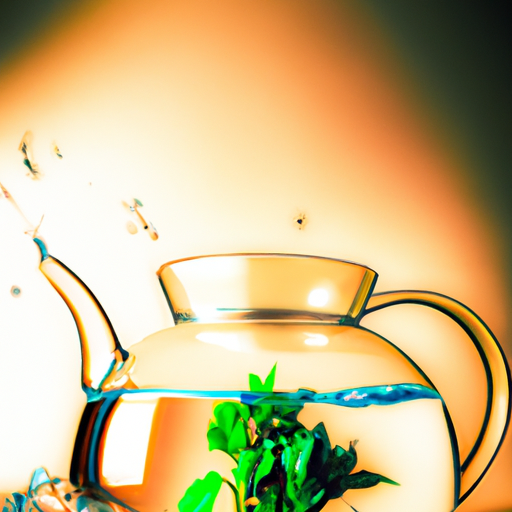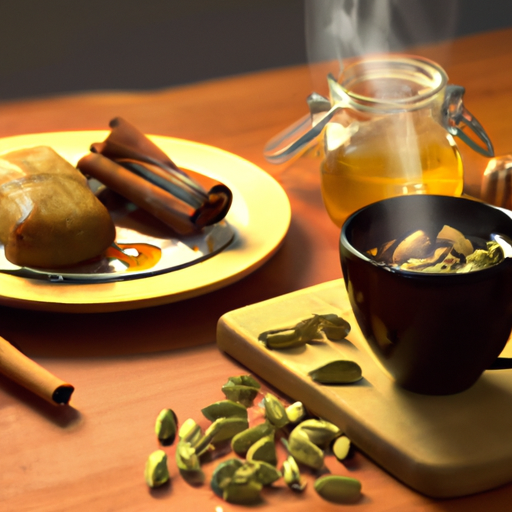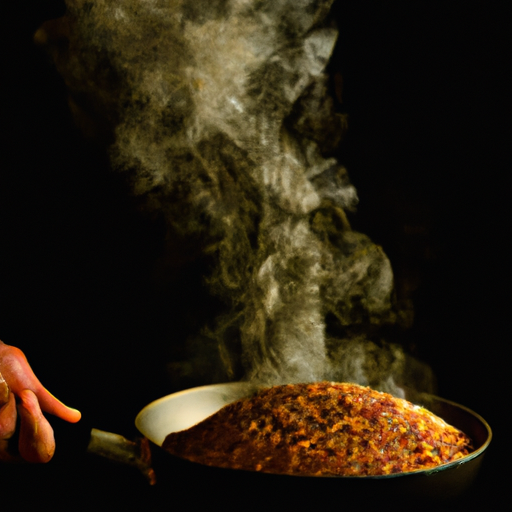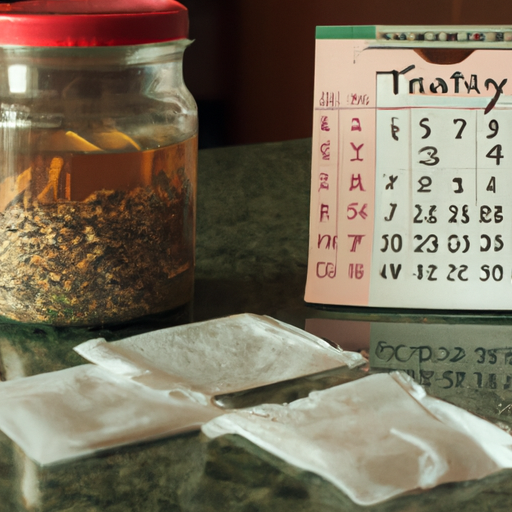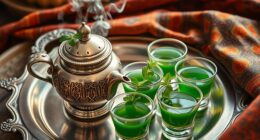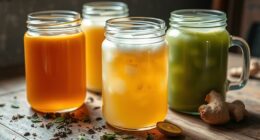As someone who loves tea, barley tea is one of the beverages I look forward to drinking in the summer. This thirst-quenching drink, which is deeply rooted in East Asian traditions, offers a distinctive taste. However, what ingredients are used to make barley tea?
In this article, I’ll break down the ingredients that go into making this delicious and healthy drink, as well as explore its cultural significance and sustainability.
Barley tea, also known as roasted barley tea or mugicha in Japanese, is a non-caffeinated beverage made from roasted barley grains. The tea has a nutty, toasted flavor and is often served cold or at room temperature.
Barley tea is a popular drink in East Asian countries like Japan, Korea, and China, where it is consumed as a refreshing summer drink and is believed to have numerous health benefits. In the following sections, I’ll delve deeper into the ingredients that make up this unique tea and explore its many uses and benefits.
Key Takeaways
- Barley tea is made from roasted barley grains.
- Some recipes may include additional ingredients such as corn or other grains for added flavor.
- Barley tea is rich in vitamins and minerals, including magnesium, potassium, and iron.
- Optional ingredients for making barley tea include honey, lemon, or ginger.
What is Barley Tea?
Barley tea is a refreshing and comforting drink made from roasted barley grains. It’s popular in many Asian countries, particularly in Japan and Korea, where it’s often served cold during the summer.
Brewing barley tea is a simple process that involves steeping roasted barley grains in hot water for several minutes. The resulting tea has a nutty, slightly sweet flavor and a light brown color.
In addition to its taste, barley tea is known for its many health benefits. It’s rich in antioxidants and has been shown to help reduce inflammation and lower blood pressure. Barley tea is also believed to aid digestion and promote relaxation, making it a popular choice for those looking to unwind after a long day.
The main ingredient in barley tea is roasted barley grains. However, some recipes may also include additional ingredients such as corn or other grains for added flavor. Regardless of the specific recipe used, barley tea is a delicious and healthy beverage that can be enjoyed year-round.
Ingredients of Barley Tea
You’re probably wondering what goes into this delicious drink, aren’t you? Well, you’ll be happy to know that all you need is water and roasted barley kernels. Barley tea ingredients are simple and straightforward, making it an easy beverage to prepare at home.
Here are the ingredients you’ll need to make a refreshing cup of barley tea:
-
Water: The base of any tea is water, and barley tea is no exception. Use filtered water for the best taste.
-
Roasted barley kernels: These are the star ingredient of barley tea. They can be found at most Asian grocery stores or online. Roasting the barley kernels gives them a nutty, toasty flavor that is unique to barley tea.
-
Optional: Some people like to add other ingredients to their barley tea, such as honey, lemon, or ginger. However, these are not necessary to make a delicious cup of barley tea.
To make barley tea, you’ll need to follow a few simple brewing techniques. First, rinse the barley kernels in cold water to remove any dust or debris. Then, add the barley kernels to a pot of boiling water and let them simmer for about 10-15 minutes. Strain the tea and let it cool before serving. You can also make barley tea in a teapot or using a tea infuser.
Barley tea is not only delicious, but it also has many health benefits. From improving digestion to reducing inflammation, barley tea is a great addition to any healthy lifestyle.
So, grab some barley kernels and start brewing your own cup of this refreshing and nutritious tea.
Health Benefits of Barley Tea
If you’re looking for a healthy and refreshing beverage, consider trying out roasted barley kernel tea, also known as barley tea. Not only does it have a unique and pleasant taste, but it also contains numerous health benefits.
One of these benefits is its ability to boost the immune system. Barley tea is rich in antioxidants and other compounds that help to strengthen the body’s defenses against illness and disease.
In addition to its immune-boosting properties, barley tea has other health benefits as well. It has been shown to lower cholesterol levels, improve digestion, and even promote weight loss. The tea is also rich in vitamins and minerals, including magnesium, potassium, and iron. These nutrients are essential for maintaining optimal health and vitality.
Overall, barley tea is a great choice for anyone looking for a healthy and delicious beverage. Not only is it packed with nutrients and health benefits, but it’s also easy to make at home. In the next section, we’ll explore how to make barley tea and enjoy its many benefits.
How to Make Barley Tea
To enjoy the many health benefits of this beverage, all you need to do is brew a batch of delicious homemade barley tea. First, gather your ingredients: barley, water, and optional flavorings like honey or lemon.
Rinse the barley in cold water and drain. Then, add it to a pot with 6 cups of water and bring to a boil. Once boiling, reduce the heat to low and let it simmer for 10-15 minutes.
Next, strain the tea into a pitcher or container and let it cool. You can drink it hot or cold, depending on your preference. If you want to sweeten it, add honey or sugar to taste. You can also add lemon or other flavorings for a more unique taste.
There are many variations of barley tea, depending on the brewing techniques used. Some people prefer to roast the barley before brewing to bring out a nuttier flavor. Others may add other grains or herbs to the mix for added flavor and health benefits. Experiment with different variations to find the one that suits your taste buds best.
In the subsequent section, we’ll explore the different variations of barley tea and how they can be made to suit your preferences.
Variations of Barley Tea
When it comes to barley tea, there are variations that can be made to suit personal tastes. As for me, I like to enjoy my barley tea both hot and cold depending on the weather.
I also prefer my tea unsweetened, but some people like to add a little sugar or honey to theirs. Additionally, some people like to mix other ingredients into their barley tea, such as ginger or lemon, for added flavor and health benefits.
Hot vs. Cold
You may have heard that drinking barley tea cold is more refreshing, but did you know that hot barley tea can actually have more health benefits?
Hot barley tea is known to help with digestion, improve blood circulation, and even aid in weight loss. This is because the hot water helps to release more of the tea’s nutrients and antioxidants than cold water does.
When it comes to brewing techniques, hot barley tea is typically brewed for a longer period of time than cold barley tea. This allows for more of the tea’s nutrients to be extracted and released into the water. However, it’s important to note that hot barley tea should not be consumed at extremely high temperatures, as this can lead to burns or scalds.
Now, let’s explore the differences between sweetened and unsweetened barley tea.
Sweetened vs. Unsweetened
When it comes to enjoying barley tea, there are two options to consider: sweetened or unsweetened. Sweetened barley tea is made by adding sugar or honey to the tea, while unsweetened barley tea is simply made with water and barley. The choice ultimately comes down to personal taste preference.
Hot or cold barley tea can also play a role in the decision to sweeten or not. Sweetened barley tea is often served cold and makes for a refreshing summer beverage. On the other hand, unsweetened barley tea is commonly served hot and can be enjoyed as a comforting and warming drink during the colder months.
Whether you prefer your barley tea sweet or unsweetened, there’s no denying the unique and delicious flavor that comes from this traditional Korean beverage. With that being said, there are also many ways to mix barley tea with other ingredients to create new and exciting flavors. From adding fruit and herbs to blending it with milk or other teas, the possibilities are endless.
So let’s explore the different ways barley tea can be mixed with other ingredients to create a truly unique and delicious drink.
Mixed with Other Ingredients
If you’re looking for a way to spice up your beverage routine, mixing in different flavors with your favorite hot or cold brew can be a game-changer. Barley tea, known for its nutty and slightly sweet flavor, can be mixed with a variety of other ingredients to create unique and delicious drinks.
Here are some ideas to get you started:
- Mix barley tea with lemon juice and honey for a refreshing summer drink.
- Add a splash of milk and a sprinkle of cinnamon for a cozy and comforting winter drink.
- Use barley tea as a base for cocktails by adding your favorite liquor and fruit juice.
- Infuse barley tea with herbs like mint or lavender for a calming and aromatic drink.
- Incorporate barley tea into baking recipes such as muffins or cakes for added flavor and nutrition.
Barley tea’s versatility makes it a great ingredient to experiment with in the kitchen. Not only can it be used in a variety of drinks, but it can also enhance the flavor of baked goods.
In the next section, we’ll explore some serving suggestions for barley tea.
Serving Suggestions
For a refreshing twist, try serving your barley tea over ice like a cool breeze on a hot summer day. Barley tea has a unique nutty flavor that pairs well with a variety of foods. In fact, in Korean culture, it’s often served with savory dishes such as grilled meats or spicy stews.
In Japan, it’s a popular beverage to serve during meals and is often paired with sushi or other seafood dishes. But barley tea isn’t just limited to being a mealtime beverage. It can also be enjoyed as a refreshing drink on its own. Some people even add a splash of lemon or honey to enhance the flavor.
If you’re feeling adventurous, try steeping some fresh mint or ginger in your barley tea for an added kick. If you’re looking to buy barley tea, you can find it at most Asian grocery stores or online retailers. Some brands even offer convenient tea bags for easy brewing.
So, whether you’re looking for a refreshing drink to accompany your meal or a soothing beverage to enjoy on its own, give barley tea a try. You might just discover a new favorite beverage.
Where to Buy Barley Tea
Now that we know how to serve barley tea, let’s talk about where to buy it. If you’re lucky enough to live near an Asian grocery store, you’ll most likely be able to find barley tea there. Look for it in the tea section or the Korean/Japanese section.
However, if you don’t have access to a local store, there are online options available. You can find barley tea on Amazon, Walmart, and other online retailers. Just make sure to read the labels carefully to ensure you’re getting pure barley tea.
If you prefer loose leaf tea, you can also find barley tea in specialty tea shops or online tea stores. Loose leaf tea allows you to control the strength of the tea and experiment with different brewing methods. However, if you’re new to barley tea, it’s recommended to start with tea bags to get a better idea of the flavor profile.
There are several options available for purchasing barley tea. If you have access to a local Asian grocery store, that’s your best bet. Otherwise, online retailers or specialty tea shops are great alternatives.
Now that we know where to buy barley tea, let’s explore its cultural significance and how it’s consumed in different parts of the world.
Barley Tea and Culture
I find it fascinating how barley tea has been a part of traditional East Asian culture for centuries. It’s not just a refreshing drink, but a symbol of hospitality and respect.
Nowadays, barley tea remains a popular beverage in modern society, enjoyed by people of all ages. Its significance in both traditional and modern culture makes it a unique and interesting topic to explore.
Traditional Use
Imagine yourself sitting on a hot summer day in Korea, sipping on a refreshing glass of barley tea made from roasted barley grains. This traditional beverage has been enjoyed for centuries and holds great cultural significance in Korean society. Barley tea traditions date back to the Three Kingdoms period (57 BC-AD 668) and has since become a staple in Korean households.
In addition to its refreshing taste, barley tea is also known for its health benefits. It is believed to aid in digestion, regulate blood sugar levels, and improve circulation. It also contains antioxidants and vitamins, making it a popular choice for those seeking healthier beverage options. As Korean culture continues to evolve, barley tea remains a beloved tradition that is passed down from generation to generation.
As barley tea becomes more popular in modern culture, its health benefits and cultural significance continue to make it a sought-after beverage.
Popular in Modern Culture
You may have noticed that this refreshing beverage is popping up more frequently in trendy cafes and health-conscious grocery stores. This shows that barley tea has become a popular choice in modern culture. It’s not just its taste and aroma that’s drawing people towards it, but also its health benefits. Barley tea is low in calories and has a natural sweetness, making it a healthier alternative to sugary drinks. It’s also rich in antioxidants, which can help reduce the risk of heart disease and cancer.
In addition to its health benefits, barley tea has cultural significance in many countries, particularly in East Asia. In Japan and Korea, it’s often served as a refreshment during meals or as a way to cool down during hot weather. In China, it’s believed to have medicinal properties and is used to treat various ailments. As a result, barley tea has become a staple in these countries, and its popularity has spread to other parts of the world.
As we move on to the next section about symbolism, it’s interesting to note how this simple beverage has become a part of various cultures and traditions.
Symbolism
Symbolism of barley tea is deeply rooted in many cultures and traditions. In Japan, it’s believed to have a calming effect on the mind and body. It’s often served to guests as a sign of respect and hospitality.
In Korea, it’s said to have medicinal properties and is often consumed to aid digestion and improve overall health.
In China, barley tea is used to symbolize the bond between family members. It’s often shared during family gatherings and special occasions.
The cultural significance of barley tea extends beyond East Asia, as it’s been used in various practices and rituals around the world. For example, it’s commonly used in spiritual ceremonies in Native American cultures. It’s believed to have purifying properties.
Additionally, in some African countries, barley tea is used as a symbol of fertility. It’s often consumed by women trying to conceive.
The symbolism of barley tea is a testament to its versatility and importance in many different cultures and traditions.
Barley tea’s symbolism is just one aspect of its many benefits, including its sustainability.
Barley Tea and Sustainability
As I wrap up my discussion on barley tea, I want to touch on its sustainability benefits.
Barley is a hardy crop that requires less water and fertilizer compared to other grains.
Furthermore, the process of making barley tea is simple and requires minimal energy consumption.
Overall, incorporating barley tea into our daily routines not only brings health benefits but also contributes to a more sustainable lifestyle.
Recap of Benefits
Alright, let’s talk about the perks of drinking barley tea – it can be a great addition to any healthy lifestyle. Not only is it low in calories and caffeine-free, but it also contains antioxidants that can help reduce inflammation in the body. Additionally, it has been shown to aid in digestion and even promote weight loss.
In terms of its cultural significance, barley tea has been used in Asian cuisine for centuries. It’s a staple in many households and is often enjoyed as a refreshing summer drink. Its nutty, slightly sweet flavor is unique and pairs well with a variety of dishes.
Overall, incorporating barley tea into your diet can bring about a variety of health benefits while also adding a touch of cultural diversity to your palate.
As we wrap up our discussion on the benefits of barley tea, it’s important to remember that incorporating any new food or drink into your diet should be done in moderation and with consideration of any potential allergies or sensitivities. With that being said, barley tea offers a variety of health benefits and is a delicious addition to any meal. So why not give it a try and see how it can benefit your body and your taste buds?
Final Thoughts
In conclusion, incorporating barley tea into your daily routine can provide a multitude of health benefits and add a unique flavor to your meals. But beyond its nutritional value, barley tea also holds cultural and sustainability significance.
Here are some reasons why:
-
Sustainability importance: Barley is a hardy crop that can grow in a wide range of environments and requires less water than other grains. By consuming barley tea, we’re supporting sustainable agriculture practices and reducing our environmental impact.
-
Cultural significance: Barley tea, also known as mugicha, is a popular beverage in East Asian cultures, particularly in Japan and Korea. It’s often served as a refreshing drink during hot weather and is also believed to have medicinal properties.
By incorporating barley tea into our daily routine, we’re honoring and celebrating the cultural traditions of these countries. Overall, barley tea is not only a delicious and nutritious beverage, but it also carries important cultural and sustainability significance. So why not give it a try and see how it can add a unique flavor and meaning to your daily routine?
Frequently Asked Questions
How does barley tea differ from other types of tea?
Barley tea, also known as mugicha, is a unique type of tea that differs from other teas in several ways. Firstly, it has a distinct and refreshing flavor profile that is nutty, toasty, and slightly sweet. This flavor comes from the roasted barley grains used to make the tea.
Secondly, barley tea has numerous health benefits, including aiding digestion, promoting hydration, and reducing inflammation. Finally, barley tea has cultural significance in East Asia, where it is commonly consumed as a refreshing summer drink.
To brew barley tea for optimal flavor and aroma, simply steep roasted barley grains in hot water for several minutes. The longer the steeping time, the stronger the flavor. Overall, barley tea is a delicious, healthy, and culturally significant beverage that’s easy to make and enjoyable to drink.
Can barley tea be consumed hot or cold?
When it comes to enjoying barley tea, the temperature preference is entirely up to personal taste. Some people prefer it hot, especially during the colder months, while others enjoy it cold during the summer.
Barley tea is incredibly versatile and can be used in unique ways beyond just drinking it. There are various barley tea recipes that incorporate it into dishes like soups, stews, and even desserts.
Overall, whether hot or cold, barley tea is a delicious and healthy addition to any beverage rotation.
Is barley tea caffeine-free?
As I take a sip of my refreshing barley tea, I can’t help but appreciate the natural goodness that comes with it. And the best part? It’s caffeine-free! So for those who are sensitive to caffeine, this is an excellent alternative.
Barley tea is made by steeping roasted barley kernels in hot water, resulting in a rich, nutty flavor that’s perfect for any time of the day. But its benefits don’t stop there. Barley tea is also known for its various health benefits, including improving digestion, reducing inflammation, and even aiding in weight loss.
So not only does it taste great, but it’s also good for you.
Are there any side effects of consuming barley tea?
When it comes to consuming barley tea, there are some potential side effects to be aware of. On the positive side, barley tea has been shown to have digestive benefits, including helping to ease indigestion and reducing inflammation in the digestive system.
However, some people may experience allergic reactions to barley, which can cause symptoms like hives, difficulty breathing, and swelling of the face, lips, tongue, or throat. It’s also possible to have an allergic reaction to other ingredients that may be included in barley tea blends.
If you’re considering trying barley tea and have any concerns about potential side effects, it’s a good idea to speak with your doctor first.
Can barley tea be used in cooking or baking?
I’ve found that barley tea can indeed be used in cooking and baking.
There are a variety of barley tea recipes available that incorporate this ingredient in different ways. For example, some recipes use brewed barley tea as a base for soups or stews, while others use it as a marinade for meats or a flavoring for desserts.
In addition to adding a unique flavor to dishes, barley tea also has health benefits that make it a great addition to any recipe.
So, if you’re looking to experiment with new ingredients in your cooking, consider trying out some barley tea recipes and see what delicious creations you can come up with!
Conclusion
In conclusion, barley tea is a refreshing and healthy beverage that has been enjoyed for centuries in various cultures around the world. Its simple yet flavorful ingredients make it a popular choice for those looking for a caffeine-free alternative to traditional teas.
The health benefits of barley tea are numerous, from aiding digestion to reducing inflammation. As I sip on my cup of barley tea, I can’t help but think of the rich history and cultural significance behind this humble drink.
From Japan to Korea to the Middle East, barley tea has been a staple in many households and is often served as a gesture of hospitality. Its sustainability and eco-friendliness also make it a responsible choice for those looking to reduce their carbon footprint.
So next time you’re in the mood for a warm and comforting beverage, give barley tea a try and experience the taste and tradition for yourself.

